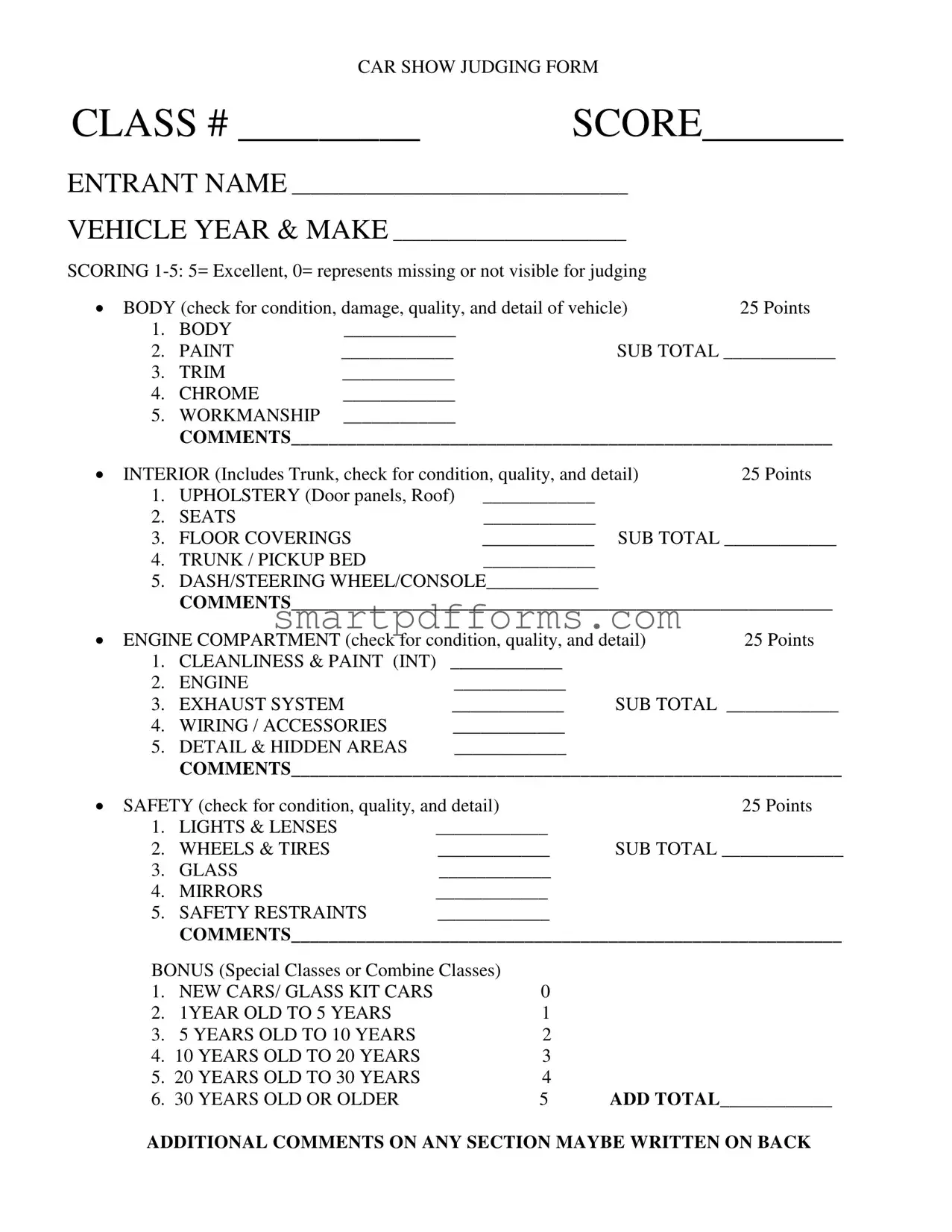What is included in the Car Show Judging Form?
The Car Show Judging Form includes evaluations for different aspects of a vehicle. These aspects are divided into four main categories with a scoring system ranging from 0 to 5 for each item, where 5 is Excellent and 0 means the item is missing or not visible for judging. The categories include the Body (covering condition, damage, quality, and detail), Interior (which also checks the condition and quality of the trunk), Engine Compartment (focusing on cleanliness, quality, and detail), and Safety (assessing the condition and quality of safety features). Each category has specific items to be scored, and there's space for comments on each. Additionally, there's a section for bonus points depending on the vehicle's age or special class.
How are points awarded on the form?
Points are awarded on a scale of 0 to 5 for each item under the categories of Body, Interior, Engine Compartment, and Safety. A score of 5 represents an excellent condition, whereas a score of 0 indicates the item is either missing or not visible for judging. Each item in the categories is given a specific allotment of points, contributing to a subtotal for each category. The scores are then totaled, alongside any bonus points for the vehicle's age class, to derive the final score.
Is it possible to get bonus points?
Yes, bonus points can be awarded based on the age of the vehicle. There are specific brackets for vehicles' age, ranging from new cars to vehicles 30 years or older, with points increasing as the vehicle gets older. This enables vehicles of different ages to compete more fairly, recognizing the effort put into maintaining older vehicles.
What is the highest possible score?
The highest possible score one can achieve on the Car Show Judging Form is primarily determined by the sum of the maximum points across all categories, which is 100 points (25 points per category for Body, Interior, Engine Compartment, and Safety). Additionally, the vehicle can earn up to 5 bonus points based on its age, making the highest possible total score 105.
Can additional comments affect the final score?
Yes, additional comments can provide context and insights that affect the final scoring. Judges are encouraged to write comments for each category to explain their ratings, highlight exceptional features, or note areas requiring attention. These comments can be especially valuable in close contests, offering a qualitative perspective alongside the quantitative scores.
Are older vehicles at a disadvantage?
No, older vehicles are not at a disadvantage. The scoring system is designed to be fair to vehicles of all ages. The inclusion of bonus points for older vehicles ensures that they are recognized for their preservation and restoration. These bonus points help to level the playing field, enabling older vehicles to compete effectively against newer models.
What should entrants focus on to score well?
Entrants should focus on the condition, quality, and detail of their vehicle's Body, Interior, Engine Compartment, and Safety features to score well. Ensuring that the vehicle is clean, well-maintained, and free of damage can significantly impact the scores. Attention to detail, such as the vehicle's paint, chrome finishes, and upholstery, as well as ensuring all safety components are in good condition, can also make a difference. Additionally, entrants should consider the vehicle's age and any potential for bonus points when preparing their entry.
How should comments be used on the form?
Comments should be used to provide additional details not covered by the scoring system. Judges can use comments to note exceptional craftsmanship, attention to detail, or areas that may require improvement. Entrants can also use the available space for comments to highlight special features or restoration efforts that might not be immediately visible. These comments can help judges make more informed decisions and provide valuable feedback to entrants.
